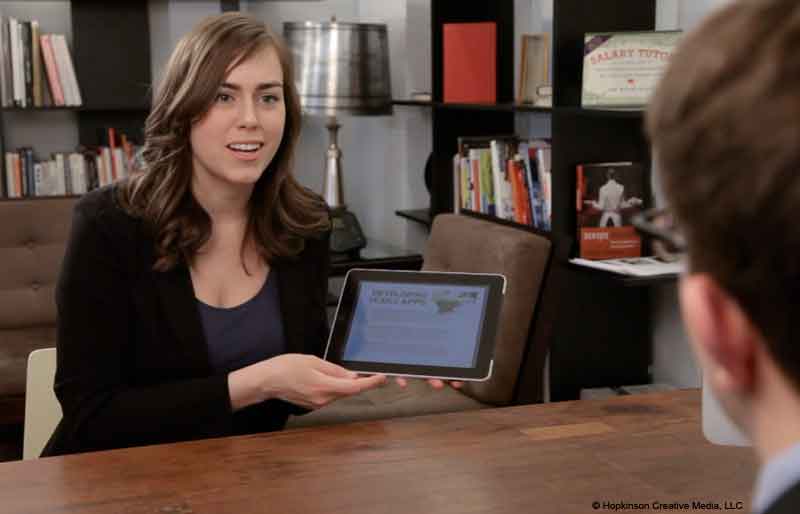Jim teams up with Body Language expert Vanessa Van Edwards to show you tips you can use when negotiating. Watch the video or check out the article below.
Body + Mind
A tilt of the head, a subtle glance, touching a certain part of the body… there are dozens of tiny micro-expressions that people make in every single conversation that project meaning – all without saying a word.
Mastering the hidden science of body language can give you an enormous advantage when building relationships, meeting new people, or even going on date.
Combine this knowledge with tips on how to negotiate your salary, and it can also make you some serious money.

She writes for the Huffington Post and has appeared on CNN, the Wall Street Journal and Business Week, speaking to audiences around the world on nonverbal communication.
See more of her work at Science of People.org.
Four steps to using body language when negotiating an offer or asking for a raise
Together, we created the video above explaining four key tips that combine my expertise – salary negotiation – with her expertise – reading body language – to supercharge your next ask for a raise or promotion in your job. Here we go.
Step 1) Pre-Meeting Preparation
There are a few things that you need to do before you walk into your boss’ office to ask for your raise or promotion.
Negotiation Tips:
1) The first thing is to keep a running account of your accomplishments on the job. In my book Salary Tutor I made up a fancy word called your “Accomplishments Manifesto,†but basically it’s a Word document or a Google Spreadsheet where you jot down positive things you’ve done on the job since you’ve been there. This could be big wins like landing a new client, setting a sales record, or launching a new product. Wherever possible, tie the accomplishment to a dollar figure that you can use later to justify a monetary increase.
2) Next, you need to know your dollar value on the marketplace for someone with your skills and experience. Do plenty of online research on sites like Salary.com, Payscale.com, Glassdoor.com, and others so you know what workers at similar positions in your location are making.
3) Next, make sure you’re in the right mindset. You’re not demanding more money, you’re not begging for a promotion, and you’re not giving any ultimatums if you don’t get a higher title. You’re confidently presenting facts in a business-like manner to justify why you deserve a raise.
Body Language Tips:
Vanessa tells us about the non-verbal steps you’ll want to take to get ready for the pitch. If you walk into that meeting nervous, anxious or angry about asking for the raise, it’s going to show, and people will pick up on it.
There was a fantastic study done by Harvard Business School researchers that illustrates this point. They equally divided two groups of participants. In one group, they had them enact for just 5 minutes what would be considered successful body language – expansive poses, taking up space, and hands on hips.
In the second group, they had them do what would be considered unsuccessful body language or defeated poses.
In other words, contracted posture, tightly held arms and legs, and hanging their head low, also for 5 minutes.
They then had both groups go into mock interviews, where they had to deliver a speech to evaluators and answer questions. These were videotaped and rated for overall performance, hire-ability, and presentation quality.
Can you guess the results?
The group that stood in the power poses for just 5 minutes before the presentation were rated higher for their speech AND were more likely to be hired. This short preparation before an interview effected the outcome.
So as a takeaway, before your next big meeting, psych yourself up by standing in strong body language positions: expansive poses, hands on hips, feet firmly planted.
Step 2: Kicking off the Meeting
Now it’s time to get to the meeting itself.
Body Language Tips:
OK, now that you are pumped up and set to walk into your manager’s office, what is the best way to begin the meeting? Studies show that up to 93% of our communication is nonverbal, so how you say something can matter even more than what you say.
Here are some simple things to try:
1) Studies have shown that job-seekers who carry more than one item into an interview can be seen as lazy or irresponsible. Thus, leave your jacket with the receptionist, throw out that large Starbucks coffee, combine your purse and briefcase, and ditch the emergency umbrella. Walking into the interview with a streamlined look will make you look more put together right off that bat.

Reports have shown that when we sit directly across from another person, there is higher rejection, less recall of what is said, and people speak in shorter sentences. So angle your chair or take a seat at angle if you have a choice when you walk into the office.
3) One common question is always, what do I do with my hands?
While it’s good to gesture to make a point and be engaged, one helpful tip is to always keep your hands above the table. Studies show that if they are hidden, people have trouble trusting you. This reaction goes back to primitive days when your hands might be hiding a weapon. So don’t put them in your lap or hide them behind your arms or under your chair.
Negotiation tips:
The next negotiation tip is to know your boss’ style, and tailor your overall approach to match theirs. For example, if they’re a bottom-line, fact-oriented boss that likes to dig into the numbers, be prepared with details to support your case, such as “Since I’ve been online sales director, our client revenues are up 24%, we’ve signed 5 new foreign accounts, and have had a $350,000 increase to the bottom line.â€
If they’re a manager with a big picture, long-term, focus, talk about the biggest problem your company is facing, look at the long term strategy, and offer insight on ways your contributions will impact that vision.
Step 3) Making The Ask
Now you’re ready to ask for that raise or negotiate an offer.
Negotiation Tips:
One simple way to present your case is by thinking past, present, future.
- Detail what you’ve done over the past year, showing a proven track record of performance
- Go over the projects you’re working on now, and if possible, attach yourself to high-profile, revenue-generating projects
- Lay out your goals for the future, describing how they align with company goals
Body Language Tips:
During the interview, you want to read body language to make sure your manager is receiving your message. When you see positive body language cues that signal positivity or excitement, you know you’re on the right track:
- Nodding
- Licking Lips
- Steepling (when people touch the tips of their fingers together)
But what about defensive body language?

A great way to handle that situation is to hand them something to hold (crafty salesmen often do this with a pen or a calculator).
Negotiation Tips:
I recommend preparing a digital portfolio of your work on the iPad or other tablet, which you can hand to your boss to get them back into an open and accommodating body language.
Employees are able to tell a story of their accomplishments, be memorable, take back control of the interview, and really really detail all the things they’ve done on the job. I include some pre-made templates in my How to Get a Raise course.
Step 4: The Closing
Before going in for the final closing you want to build rapport.
Negotiation Tips:
This is the point that you actually need to ask for that raise. Summarize your case, reiterate the accomplishments you’ve had over the past year, your research on the current market range, and your goals for the future. Then be specific in your ask.
Are you looking for a higher salary, an increased title, more vacation, or more responsibility? Then, as important as it is that you’ve been presenting for some time, the next key thing to do is the opposite: LISTEN. Sit back and honestly listen to your boss’ reaction, what their budget situation is, and how they can help you.
Body Language Tips:
Even though you’ve now made your case and are listening, Vanessa recommends not relaxing with your body language just yet. She advises her clients to lean in when making strong points, which act as a nonverbal exclamation point. Don’t lean back or that may show nervousness or disengagement.
Conclusion
I hoped you liked these four negotiation and body language tips. While it’s great to get a quick overview, there are so many more tips and techniques that we’d like to share.
Looking to delve deeper into salary negotiation tips or body language signs?
- My online courses can help give you exactly what you need to earn more. Start with my free Negotiation Mindset course
- Vanessa has amazing resources on her site, Science of People.org, and you can get her Secrets Of Body Language course on Udemy for 50% off.
Note: A version of this article also appeared on The Huffington Post.




